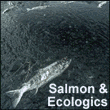forum
library
tutorial
contact

Puttin' Down the Hammer
by Annette Cary, Herald staff writerTri-City Herald, August 17, 2005
|
the film forum library tutorial contact |

|
Puttin' Down the Hammerby Annette Cary, Herald staff writerTri-City Herald, August 17, 2005 |
The ground shook just south of the Hanford nuclear reservation at 8 a.m. Tuesday as 1,000 horsepower of vibratory hammer pounded a 28-foot-long casing into the ground.
It was the final demonstration without using real waste of a new technology that North Wind of Richland is proposing to dig up Hanford waste quickly, relatively inexpensively and without bringing workers into direct contact with buried radioactive and hazardous chemical waste.
The company, based in Idaho, is proposing driving a casing into the ground, capping the bottom and top, then lifting the casing out with waste encapsulated inside.
"Our approach was to look at what was commercially available and bring it to bear on the (cleanup)," said Mark Riess, vice president of Washington state operations for North Wind.
Under a $4.7 million Department of Energy grant, it focused on the problem of digging up vertical pipes used to hold waste in two of Hanford's most notorious burial grounds, 618-10 and 618-11, not far from the Columbia River.
They were used in the 1950s and 1960s to dispose of laboratory waste from research and testing for the production of plutonium for the nation's nuclear weapons program. Some loads hauled from the 300 Area just north of Richland to the burial grounds were so radioactive that truck drivers had to be replaced halfway through their 10-mile drive.
Much of the worst waste was dumped into about five caissons, underground steel chambers connected to the surface by a crooked and slanted pipe.
More of the waste was deposited in 148 vertical pipes. Five 55-gallon drums were welded end to end and buried for each. Then containers of laboratory waste, ranging from about the size of a juice can to five-gallon buckets, were dropped down the pipes.
It's those vertical pipes North Wind is proposing to encase within the ground and safely remove intact, even if they've corroded over the last half-century.
Tuesday morning the vibratory hammer suspended from a crane took just four and a half minutes to pound a casing into the ground. It surrounded a mock waste pipe at North Wind's Cold Test Facility on Horn Rapids Road, five miles south of Burial Ground 618-10. The other burial ground is next to the northwest corner of the Energy Northwest complex.
The casing was lined with four pieces of rebar that would be pounded down to bend around the bottom of the vertical pipe and four tubes for pumping grout to the bottom of the pipe to mix with the soil. It should have cured overnight into a rebar-enforced, grout plug to close the bottom end of the pipe.
The casing can be drawn from the ground today and encased in a bright-yellow sleeve planned to prevent any contamination from escaping, particularly if pipes have corroded and allowed surrounding soil to be contaminated.
In actual use, radiation detection equipment would have been temporarily inserted inside the casing to make sure workers knew how radioactively hot the pipe was before it was removed.
Part of North Wind's grant, the most recent of two in a phased program to narrow DOE's search for cleanup technology, was used to review historical records to better understand what wastes the pipes might hold.
The company believes that most may contain low enough levels of radioactive wastes that the enclosed pipes may be taken without further treatment to the Environmental Restoration Disposal Facility, a waste site in central Hanford, for permanent disposal, Riess said.
Tuesday's test was the last of four full-scale demonstrations of the project at North Wind's Cold Test Facility.
The next step would be to demonstrate it on one of the vertical pipes in the two burial grounds, which would require about $1.1 million from DOE in a tight budget year.
DOE is interested in proving the technology not just for use at Hanford, but also possibly other DOE sites, said Mark French, project director for solid waste disposition with DOE's Richland Operations Office. DOE also faces a legal deadline to complete the design, scheduling and planning to cleanup the 618-10 and 618-11 Burial Grounds by March 31, 2007.
learn more on topics covered in the film
see the video
read the script
learn the songs
discussion forum
